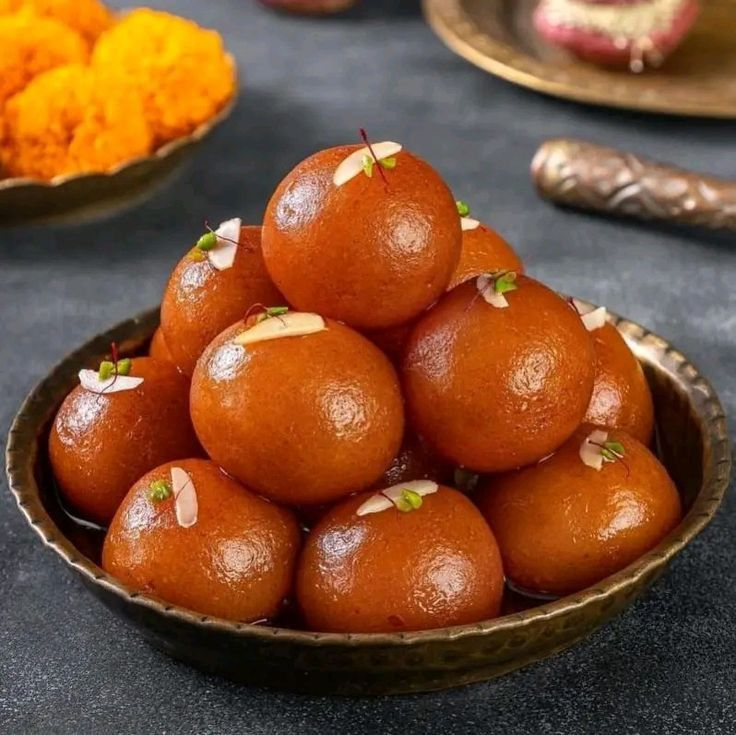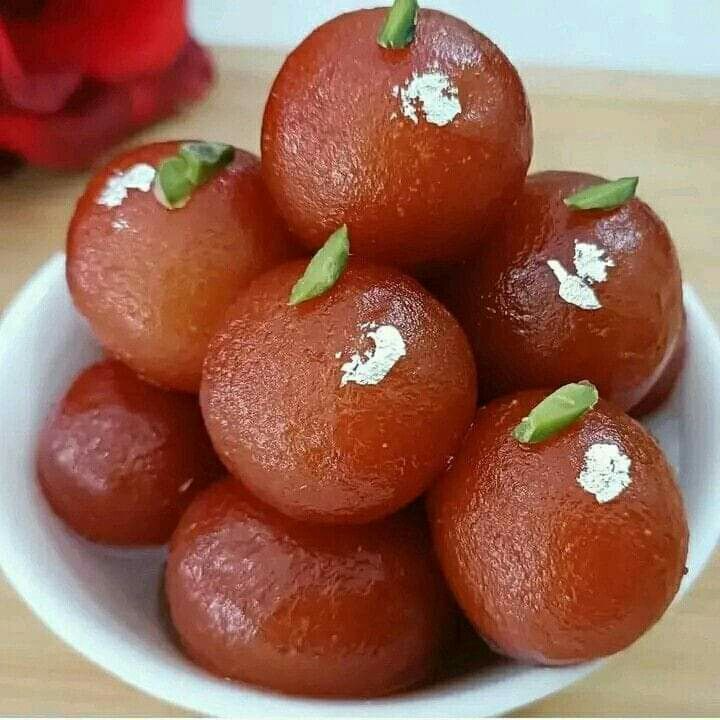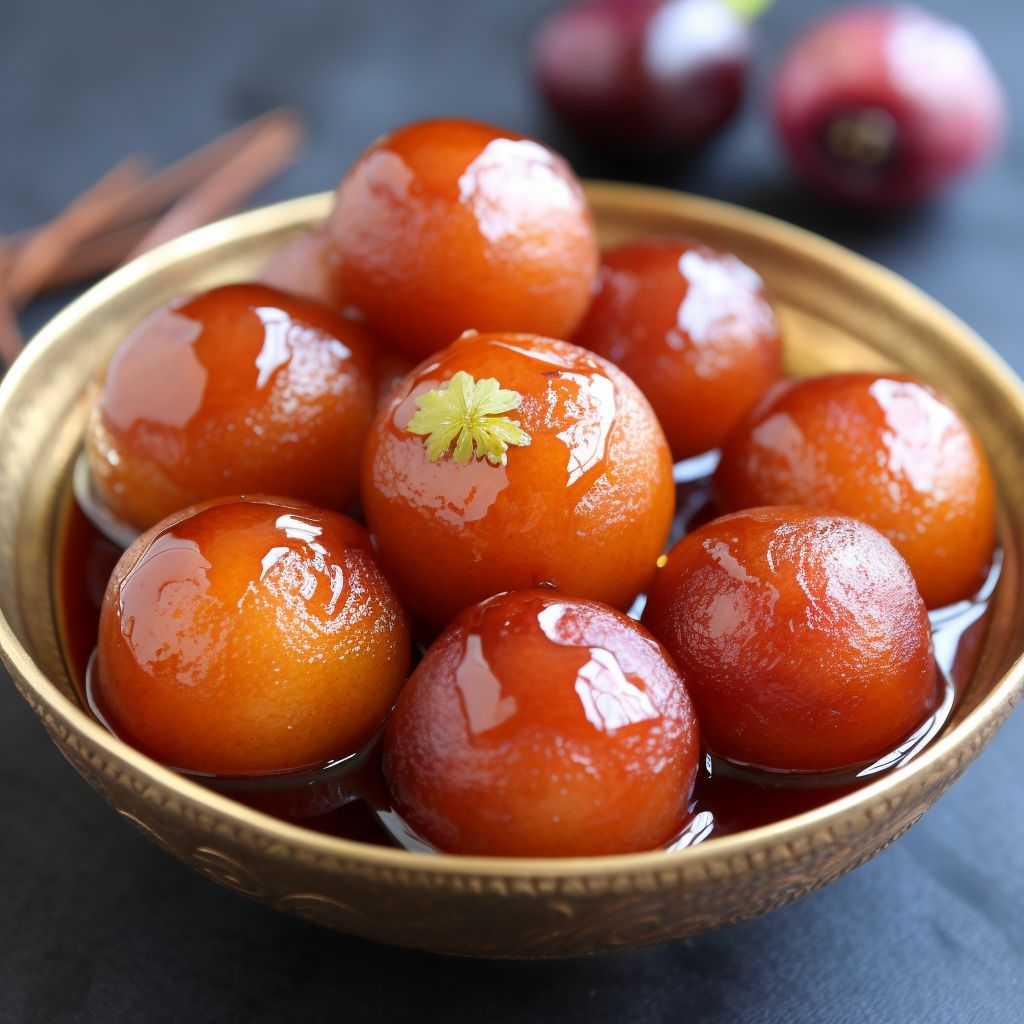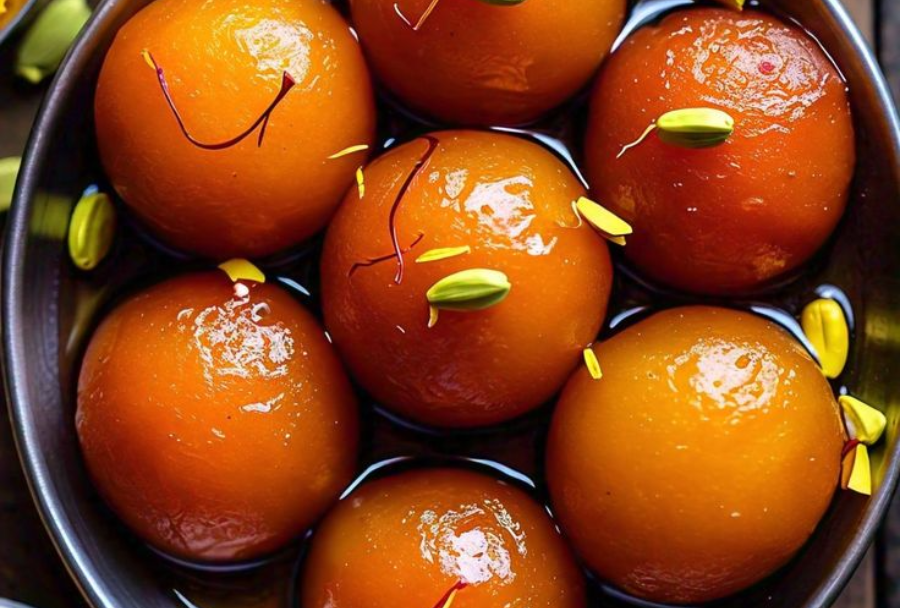Gulab Jamun — the melt-in-the-mouth dessert drenched in fragrant rose-scented sugar syrup — is one of India’s most beloved sweets. Whether served hot during weddings, festive cold in thalis, or as a guilty pleasure from the sweet shop, gulab jamuns hold a special place in Indian culinary heritage. With their pillowy texture, rich taste, and heavenly aroma, they never fail to bring smiles to every celebration.
There are some sweets that transcend the ordinary, sweets that carry the warmth of a grandmother’s kitchen, the laughter of family celebrations, and the aroma of festivities from every corner of India. One such delight is Gulab Jamun – a beloved Indian dessert that is more than just a sweet treat. It’s a symbol of joy, tradition, and indulgence rolled into soft, golden spheres soaked in fragrant sugar syrup. Whether it’s a wedding, a birthday, a religious celebration, or simply the end of a comforting meal, Gulab Jamun inevitably finds a place at the table, radiating nostalgia and sweetness in every bite.
Soft, spongy, and melt-in-the-mouth, Gulab Jamun is cherished across generations and regions. The name itself conjures warmth – “Gulab” meaning rose, referring to the floral notes often used in the syrup, and “Jamun,” the name of a dark purple Indian fruit that the dessert’s shape and color resemble after soaking. But beyond the name lies a story steeped in history, cultural richness, and culinary finesse.
The roots of Gulab Jamun stretch far back into the past. It’s said to have originated in medieval India, inspired by Persian and Turkish desserts brought to the subcontinent by invaders and traders. The Mughals, known for their extravagant culinary tastes, are often credited with refining this dessert, introducing the fragrant rose water and cardamom that give it such a distinctive aroma. Over time, regional adaptations emerged – from the khoya-based North Indian version to the flour-and-milk-powder variations popular in modern kitchens.
What makes Gulab Jamun truly stand out is its textural contrast and balance of flavors. The outer layer is fried to a perfect golden brown, offering just the right amount of resistance before yielding to a soft, almost creamy center. Soaked in a warm sugar syrup that’s often infused with rose water, saffron, or cardamom, each bite offers a symphony of sweetness, warmth, and aromatic elegance. It’s not overly sugary but delicately balanced – a hallmark of well-made Indian sweets.
The process of making Gulab Jamun is almost meditative. Traditionally made with khoya (dried milk solids), a touch of flour, and a hint of baking soda, the dough is kneaded until smooth and shaped into small balls. These are then deep-fried slowly over low heat to ensure uniform cooking, achieving that iconic rich color and texture. Once fried, they are gently dropped into the prepared syrup where they soak and swell, absorbing flavor and becoming irresistibly juicy.
While the classic recipe remains iconic, modern interpretations have given Gulab Jamun a new life. From fusion desserts like Gulab Jamun cheesecake and ice cream to chocolate-stuffed or dry fruit-filled variations, the sweet continues to evolve without losing its soul. Even in fine-dining restaurants and contemporary weddings, you’ll find creative reimaginings that bring a twist to the traditional while honoring its roots.
What’s particularly heartwarming about this dessert is its universality. Across India – whether in the deserts of Rajasthan, the backwaters of Kerala, or the high-rises of Mumbai – you’ll find it on menus and mithai boxes. Even beyond borders, it has won hearts in Pakistan, Nepal, Bangladesh, Sri Lanka, and among the Indian diaspora across the globe. It’s a dessert that tells stories of home, of celebrations, of festive chaos, and quiet indulgence after a long day.
In many Indian households, making Gulab Jamun from scratch is a family ritual. It’s often the first dessert children learn to make with their parents or grandparents – a labor of love that teaches patience, precision, and the value of tradition. The unmistakable aroma of syrup bubbling on the stove and dough being rolled between greased palms marks the beginning of something special. There’s an emotional richness to it that transcends flavor – it’s about belonging, memory, and shared sweetness.
In today’s fast-paced world, where instant mixes and store-bought sweets have become the norm, making Gulab Jamun at home brings a sense of connection to one’s roots. It’s a gentle reminder to slow down and savor – not just the taste, but the process. And when served warm, with a drizzle of syrup or a scoop of vanilla ice cream, it becomes an experience that’s both comforting and luxurious.
So, whether you’re a seasoned sweet lover or exploring Indian cuisine for the first time, Gulab Jamun is a must-try. It is more than just a dessert—it is a celebration of culture, family, craftsmanship, and the timeless Indian love for food that nourishes both body and soul.
In this 5000+ word blog post, we’ll explore everything about Gulab Jamun: from its historical roots and cultural symbolism to an in-depth guide on preparing them perfectly at home. Along the way, you’ll discover regional styles, pro techniques, mistakes to avoid, and much more to ensure your homemade gulab jamuns are just as delicious as those from your favorite mithaiwala.
What is Gulab Jamun?

Gulab Jamun is a traditional Indian dessert made from khoya (milk solids) or milk powder, shaped into soft dough balls, deep-fried till golden brown, and soaked in sugar syrup flavored with rose water, cardamom, and saffron.
Gulab Jamun is one of India’s most iconic and beloved desserts—a soft, spongy, deep-fried milk-based sweet soaked in fragrant sugar syrup. These golden-brown balls are made primarily from khoya (dried milk solids) or milk powder, combined with a small amount of flour and a leavening agent to create a dough that’s kneaded, shaped into smooth balls, and deep-fried until golden. Once fried, they are gently placed into warm sugar syrup infused with cardamom, rose water, or saffron, where they soak up the flavors and become moist, sweet, and irresistibly rich.
The name “Gulab Jamun” is derived from two words: gulab, which means rose (referring to the rose-scented syrup), and jamun, a dark purple Indian fruit similar in size and appearance to the dessert once soaked. Though now deeply embedded in Indian culinary culture, its origins trace back to Central Asia and Persia. It is believed that the dessert was brought to India during the Mughal era, where it was refined and adapted to suit local tastes and ingredients. Over the centuries, it became a staple at Indian festivals, weddings, religious ceremonies, and family celebrations.
The beauty of Gulab Jamun lies in its delicate texture and layered flavor. On the outside, it has a gentle firmness from frying, while the inside remains pillowy soft, almost melt-in-the-mouth. The sugar syrup, lightly flavored and never overpowering, adds depth and warmth, making each bite a perfect harmony of sweetness and aroma. While traditionally served warm, many enjoy it chilled or paired with a scoop of vanilla ice cream for contrast.
In India, no festival feels complete without Gulab Jamun. From Diwali and Eid to Holi and birthdays, it holds an emotional and celebratory value in Indian households. Even in restaurants and street-side sweet shops (mithaiwalas), this dessert commands a special place in the display case—often the first to sell out.
Although the traditional recipe uses khoya, modern versions often use milk powder, which simplifies the preparation process. Variations also include filling the sweet with dry fruits, using jaggery syrup instead of white sugar, or even flavoring it with kewra, saffron, or gulkand (rose petal preserve). There are also regional spins like Kala Jamun, which is slightly darker in color and sometimes filled with nuts or mawa.
Across the Indian diaspora, Gulab Jamun remains a cherished link to home. It’s popular not just in South Asia but also in countries like the U.K., the U.S., Canada, and the Middle East, wherever Indian communities reside.
In essence, Gulab Jamun is more than just a dessert—it is a cultural treasure. It represents the richness of Indian hospitality, the warmth of shared meals, and the timeless pleasure of sweets made with love. Whether made at home or enjoyed at a celebration, it continues to bring smiles, nostalgia, and an unbeatable sense of indulgence.
The name comes from “Gulab” (rose) for its floral aroma and “Jamun” (a small Indian berry) due to its size and color. Rich, fragrant, and decadently sweet, it’s a dessert enjoyed during Diwali, Eid, Holi, weddings, and countless special occasions.
History & Cultural Significance
Gulab Jamun has Mughal roots and is believed to be inspired by Turkish and Persian desserts like “luqmat al qadi”. When the Mughals brought this technique to India, it fused with local ingredients like khoya and desi ghee, evolving into what we now know as Gulab Jamun.
From halwai shops in Varanasi to Bengali sweet stores and royal Rajasthani kitchens, this dessert became a part of regional culinary identities. Today, Gulab Jamun is synonymous with Indian festivity, sweetness, and hospitality.
Ingredients
For the Dough:
- 1 cup khoya (grated or crumbled)
- 1/4 cup maida (all-purpose flour)
- 2 tbsp milk (or as needed to bind)
- 1/4 tsp baking soda
- Ghee or oil for deep frying
For the Sugar Syrup:
- 1.5 cups sugar
- 1.5 cups water
- 1/2 tsp cardamom powder
- 1 tbsp rose water or 3-4 rose petals
- A few strands of saffron (optional)
- 1/2 tsp lemon juice (prevents crystallization)
Cooking Science: What Makes Gulab Jamun So Spongy?
The key is in kneading a soft dough that isn’t overworked. Khoya provides richness, while a touch of maida gives structure. Baking soda helps with fluffiness and softness.
The syrup should be warm (not boiling) when you add the fried balls. This ensures even absorption and prevents collapse. Letting them soak at least 2 hours allows flavors to develop beautifully.
Step-by-Step Recipe

Step 1: Prepare the Sugar Syrup
- In a saucepan, combine sugar and water.
- Heat till sugar dissolves, add cardamom, saffron, and rose water.
- Simmer 4–5 minutes. Add lemon juice. Keep syrup warm.
Step 2: Make the Dough
- Combine khoya, maida, and baking soda in a bowl.
- Add milk slowly and mix gently into a soft, smooth dough.
- Cover and rest for 10 minutes.
Step 3: Shape the Balls
- Grease hands, divide dough into equal portions.
- Roll into smooth crack-free balls. Avoid pressure.
Step 4: Fry the Jamuns
- Heat ghee/oil on low to medium flame.
- Test with one ball – it should rise slowly.
- Fry in batches, turning gently till evenly golden brown.
- Drain and let sit 1 minute.
Step 5: Soak in Syrup
- Place fried balls into warm syrup.
- Let soak for 1–2 hours minimum.
Step 6: Serve
- Serve warm or chilled, garnished with slivers of pistachios or rose petals.
Watch the Video Tutorial
Prefer visuals? Here’s a detailed video showing how to make perfect Gulab Jamun: ➡️ Watch Gulab Jamun Recipe Video
Variations
- Kala Jamun: Darker version with a hint of paneer or semolina
- Dry Gulab Jamun: Syrup-soaked but served dry with powdered sugar
- Bread Gulab Jamun: Made with white bread slices as a shortcut
- Stuffed Gulab Jamun: Filled with dry fruits or cardamom-sugar paste
Serving Suggestions
✅ With Rabri (thickened milk)
✅ As a dessert after biryani or festive meals
✅ With vanilla ice cream (fusion delight!)
✅ Garnished with silver leaf (varak) for royal touch
Nutritional Info (per piece)
- Calories: ~150
- Fat: ~5g
- Carbs: ~25g
- Protein: ~2g
While high in sugar, occasional indulgence is completely worth it!
Common Mistakes to Avoid
- Overkneading the dough (makes jamuns hard)
- Frying on high heat (raw inside)
- Adding jamuns to boiling syrup (they shrink)
- Not soaking long enough
Extended FAQs

Q: Can I use milk powder instead of khoya?
A: Yes, mix milk powder, ghee, and milk to form khoya-like dough.
Q: Can I air-fry or bake them?
A: Traditional taste is best from deep-frying, but yes, it’s possible.
Q: Can I store gulab jamun?
A: Yes, refrigerate in syrup up to 5 days. Warm before serving.
Q: Can I make ahead for festivals?
A: Definitely! Make 1 day prior for best syrup absorption.
Pro Tips
✅ Use fresh soft khoya
✅ Syrup should always be warm, not hot or cold
✅ Add lemon juice to syrup to avoid crystallizing
✅ Let dough rest for best texture
✅ Fry patiently for even browning
Why This Recipe Works
✅ Simple ingredients, rich flavor
✅ Authentic Mughal-era technique
✅ Soft texture, perfect sweetness
✅ Foolproof even for beginners
Conclusion
Gulab Jamun is more than just a dessert; it’s an emotion deeply embedded in the Indian culinary psyche. Whether part of a wedding feast, a temple offering, or a post-meal indulgence, its appeal is truly timeless.
With this detailed guide, you’re equipped to make flawless Gulab Jamuns that are soft, spongy, and soaked to perfection in rose-kissed syrup. So gather your ingredients, warm up the pan, and dive into the joyful tradition of making this sweet treasure at home.


